Iron, comprising approximately five percent of the Earth’s crust, is a common element found in drinking water sources nationwide, particularly in regions dependent on private wells. While iron is a vital mineral in numerous diets, an excess amount in your water can lead to health issues and domestic challenges.
Discover the reasons behind the presence of this bothersome and sometimes harmful metal in your tap water, understand the safe levels for consumption, learn how to detect its presence in your water supply, and explore the importance of eliminating it.
How can I detect the presence of iron in my home’s tap water?
Is your tap water exhibiting shades of red, brown, yellow, or orange? Notice striking orange marks in your sink, toilet, or on dishes and clothes? Maybe the water has a metallic taste, unpleasant odor, or creates a rainbow-like film on tea or coffee in the sunlight. These symptoms often point to iron contamination in your water, but accurate identification requires water testing.
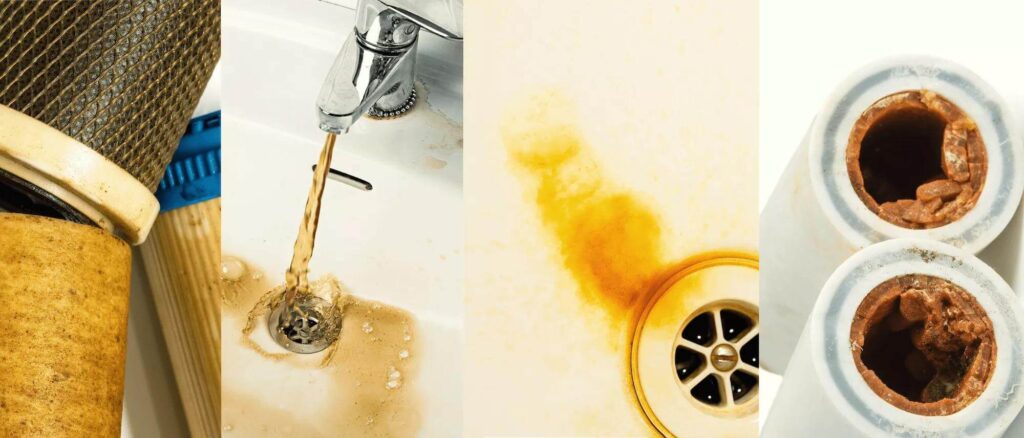
Testing your water is key to confirming iron presence and gauging its concentration. Home testing kits usually involve a simple process: dipping a strip into the water and comparing the color change to a reference chart. For a more detailed analysis, including identifying the type of iron and detecting other potential contaminants, consider a certified laboratory test.
If you opt for lab testing, reach out to your state or local health department for a directory of state-certified labs, or explore an interactive map online for options. Alternatively, customers can conveniently purchase testing kits online to conduct their own water analysis.
Understanding the specific type of iron in your water can illuminate its source and inform the most effective removal strategy, helping you eliminate this unwelcome intruder for good.
How much iron in water is considered safe?
The U.S. Environmental Protection Agency (EPA) oversees iron levels in drinking water, classifying it as a secondary contaminant. This means that while iron is not deemed hazardous to health, its presence above the EPA’s recommended threshold of 0.3 milligrams per liter (mg/l) can impact the aesthetic qualities of your water, including its color, taste, and smell. Beyond the guideline limit, iron becomes a domestic nuisance, capable of staining and corroding a variety of household items – from laundry and glassware to dishes and plumbing fixtures like bathtubs and sinks.
How does iron typically enter our household water supply?
Iron naturally exists in the earth’s crust, present in soil and rocks. During rainfall or snowmelt, water permeates these iron-rich layers, absorbing and dissolving iron, thus contaminating various natural water sources, including aquifers that feed well systems. This process often leads to iron in well water.

Additionally, iron can enter tap water through corroded plumbing. Exposed to oxygen and water, iron components may oxidize, creating rust. This rusting can be more pronounced in acidic water conditions (with a pH below 7), causing rust particles to dislodge and mix with the water flow, reaching your home’s faucets and other outlets.
As a result, household water used for drinking, cooking, bathing, and cleaning can contain traces of iron. In areas with older city pipelines, widespread rust issues may affect entire neighborhoods, leading to a common problem of iron-laden water.”
Benefits of Removing Iron from Your Tap Water
Is it necessary to remove iron from your tap water, especially when it’s primarily an aesthetic issue at lower concentrations? The answer is a resounding yes! Addressing iron in your water brings multiple important advantages, both for the wellbeing of your household and for health-related reasons:
1. Improved Water Pressure
Picture this: You’re ready for a calming bath, but the water in the tub fills up agonizingly slow. Or, you’re trying to pour a glass of water, but all you get is a slow drip. Daily routines like washing dishes, taking showers, doing laundry, and even watering your plants suddenly become more difficult and time-consuming.
This frustration can be caused by the buildup of iron particles in your home’s pipes and plumbing, leading to clogs and reduced water flow. By eliminating iron from your water supply, you can ensure consistent water pressure in your home. This means your everyday activities can be completed efficiently, allowing you to enjoy your day without unnecessary delays.
2. Cleaner Laundry, Fixtures, and Kitchenware

Is there anything more aggravating than retrieving your laundry, only to find your crisp whites marred by reddish, yellow, or brownish rust stains? And it’s not just your clothes – the same unsightly stains are visible on your bathroom fixtures, kitchen equipment, and even on your dishes and utensils.
Iron in water can indeed be troublesome, but once it’s filtered out, the rewards are immediate. Your fabrics will stay bright and pristine for much longer, and your fixtures and appliances will appear cleaner and more sanitary. This is particularly vital when you’re expecting guests – a clean, stain-free home makes a great impression.
3. Longer Lasting Pipes and Appliances
Not only does iron disrupt your daily life, as previously mentioned, but it also poses a risk to your plumbing and appliances. For example, the reduced water flow due to iron accumulation can leave water sitting in pipes. This stagnation, particularly in the presence of acidic water, can accelerate corrosion in metal pipes.

Additionally, low water pressure might lead to uneven water distribution if you have a shared water line system. This can strain your plumbing, potentially causing leaks or even significant water damage.
This issue extends to appliances connected to your water system as well. They can suffer from stress due to low pressure, leading to leaks, malfunctions, or complete breakdowns, ultimately shortening their lifespan and efficiency.
By removing iron from your water, you’re not just improving its quality; you’re also protecting your plumbing and appliances from clogs and other damages that could result in expensive repairs and replacements, ensuring their longevity and optimal performance.
4. Healthier Skin and Hair
Iron in tap water affects more than just appliances and fixtures; it can also take a toll on your hair and skin. Bathing or showering in water laden with iron can deplete moisture from your body, which is essential for maintaining vibrant and healthy skin and hair.

With continued exposure, you might find your hair becoming dry and fragile, while your skin may feel parched and itchy, exacerbating conditions like acne and eczema. Prolonged contact with iron-rich water can even accelerate skin aging, leading to early wrinkles and severe irritation.
Thankfully, by filtering out iron from your water supply, you can avoid these issues. This simple solution eliminates the need for additional beauty treatments to combat dryness and discoloration, helping to preserve the health, elasticity, and radiance of your skin and hair.
5. Creating Healthier and More Flavorful Meals and Drinks at Home
Using water high in iron for cooking can result in meals with an unappealing, darkened hue. Similarly, homemade beverages might take on an undesirable black or brown tint. Even vegetables are not immune; they too can turn black when boiled in water contaminated with iron.

Fortunately, the solution is straightforward: filtering out iron from your tap water. This simple step can significantly enhance the taste, appearance, and nutritional value of your home-cooked meals and beverages. Of course, this improvement assumes that your recipes are already perfect in terms of ingredient choice and proportions.
6. Enhancing Your Water: Better Taste, Smell, and Clarity
Imagine a glass of water that’s as clear as crystal, not resembling coffee or iced tea in appearance. It should be free from any metallic or garlicky flavors and devoid of any metallic, sewer-like, or sulfurous odors. Unfortunately, this isn’t the reality for many homeowners dealing with iron-contaminated water. Eliminating this metal from your water supply can transform it into a drink that’s visually clear, tastes pure, and smells fresh. Such an improvement in water quality might just be the motivation you need to increase your daily water intake and enhance your overall hydration habits.
7. Tremendous Benefits for Your Health
Iron in drinking water is generally not a health hazard at low levels, but at higher concentrations or when accompanied by harmful bacteria, it can become toxic. Excessive iron accumulation in the body can cause hemochromatosis, a serious condition.
- Irregular heartbeat or arrhythmia
- Risk of heart failure
- Liver complications such as cirrhosis, enlargement, cancer, and failure
- Joint damage leading to arthritis
- Increased likelihood of diabetes
- Issues affecting the spleen, adrenal and pituitary glands, gallbladder, and thyroid
- Reproductive challenges, including erectile dysfunction and early menopause
- Altered skin tone, tending towards gray or bronze
- Skin damage, including premature wrinkles
If left untreated, hemochromatosis can have fatal consequences. However, there’s a silver lining: Regularly filtering iron from your drinking water can greatly reduce the risks associated with these health issues.
A Guide to the Forms of Iron in Tap Water and How to Remove Each
Water can contain iron in multiple forms, and each form demands a specific filtration approach for successful removal. Let’s explore the different methods available for extracting iron from tap water, tailored to the particular type of iron it contains:

Ferric Iron
If your tap water has a rusty, red, or yellow hue, it’s likely due to ferric iron, commonly referred to as ‘red water’ iron or insoluble iron. This type of iron doesn’t dissolve in water and is in an oxidized state, often visible as small rust particles floating in standing water. The good news is that ferric iron is relatively easy to filter out and remove from your water supply.
How do you remove ferric iron from water?
A whole-house iron filtration system is an excellent choice for comprehensively addressing the problem of iron in tap water, capable of removing both ‘red water’ and ‘clear water’ iron. This system is effective in eliminating iron up to 7 parts per million (ppm), ensuring that the water in every part of your home is clean and iron-free.
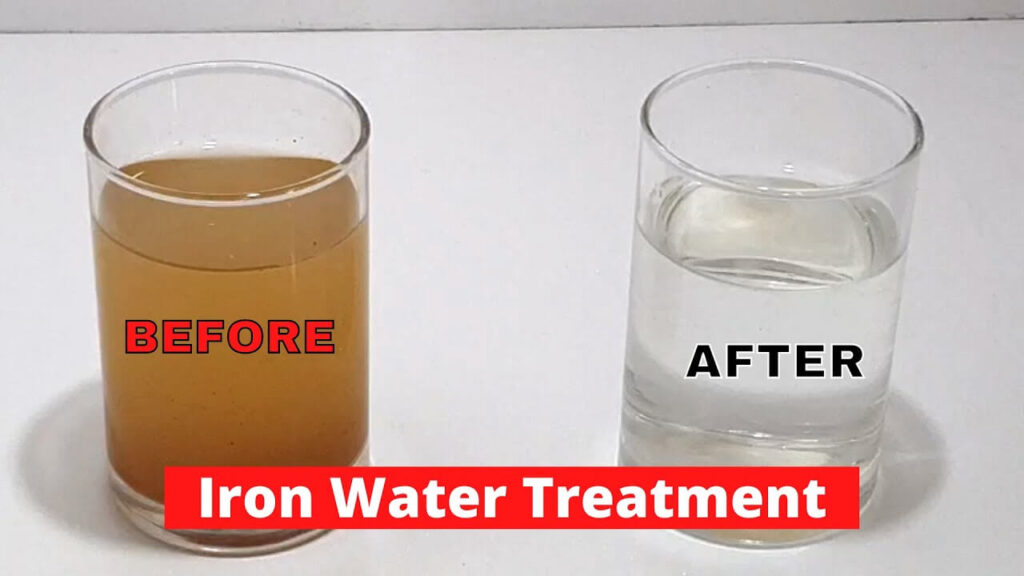
The process involves:
- Water entering the tank’s air cavity, leading to the oxidation of iron, manganese, and hydrogen sulfide.
- The greensand filter bed within the system captures these oxidized contaminants, preventing their re-entry into your water supply.
- Regular backwashing cleans the greensand bed of trapped impurities and refreshes the tank’s air pocket.
- The result is purified water distributed throughout your home’s internal plumbing.
However, while a whole-house system offers a more comprehensive solution, it’s important to consider the higher maintenance costs and the need for professional installation. For homes with only small amounts of ferric iron, simpler solutions like sediment or carbon filters might be more cost-effective, although these can become clogged with higher iron levels, so a thorough water test is advised before choosing this option.
Sediment Filter
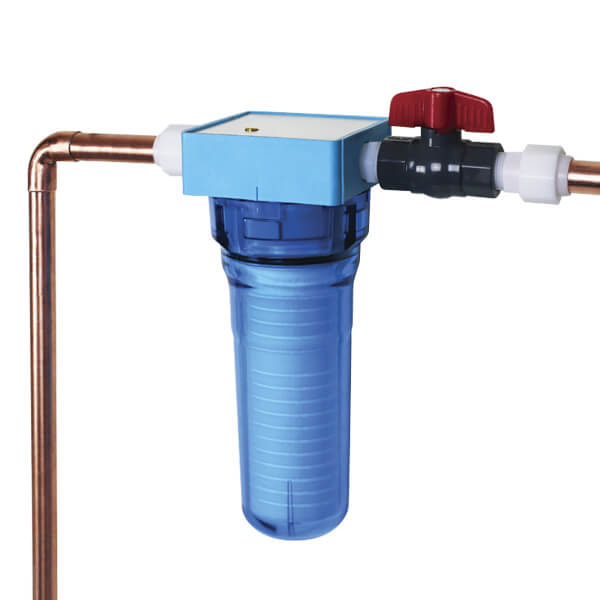
Think of a sediment filter like the mesh on a screen door: it keeps unwanted elements out while letting the essentials pass through. Just as the screen keeps insects out but allows fresh air in, a sediment filter uses its fine pores to prevent suspended solids from entering your plumbing, while still allowing water to flow smoothly.
These filters excel at trapping fine particles, such as ferric iron, dirt, rust, and sand – essentially anything larger than the filter’s micron size. To ensure effective filtration of ferric iron from your water, it’s crucial to choose a sediment filter with a sufficiently small micron rating.
Carbon Filter
Primarily aimed at addressing chlorine, as well as unpleasant tastes and odors in water, activated carbon filters can also be capable of removing additional impurities, including iron. Their efficiency in iron removal largely hinges on the filter’s pore size and specific certifications.
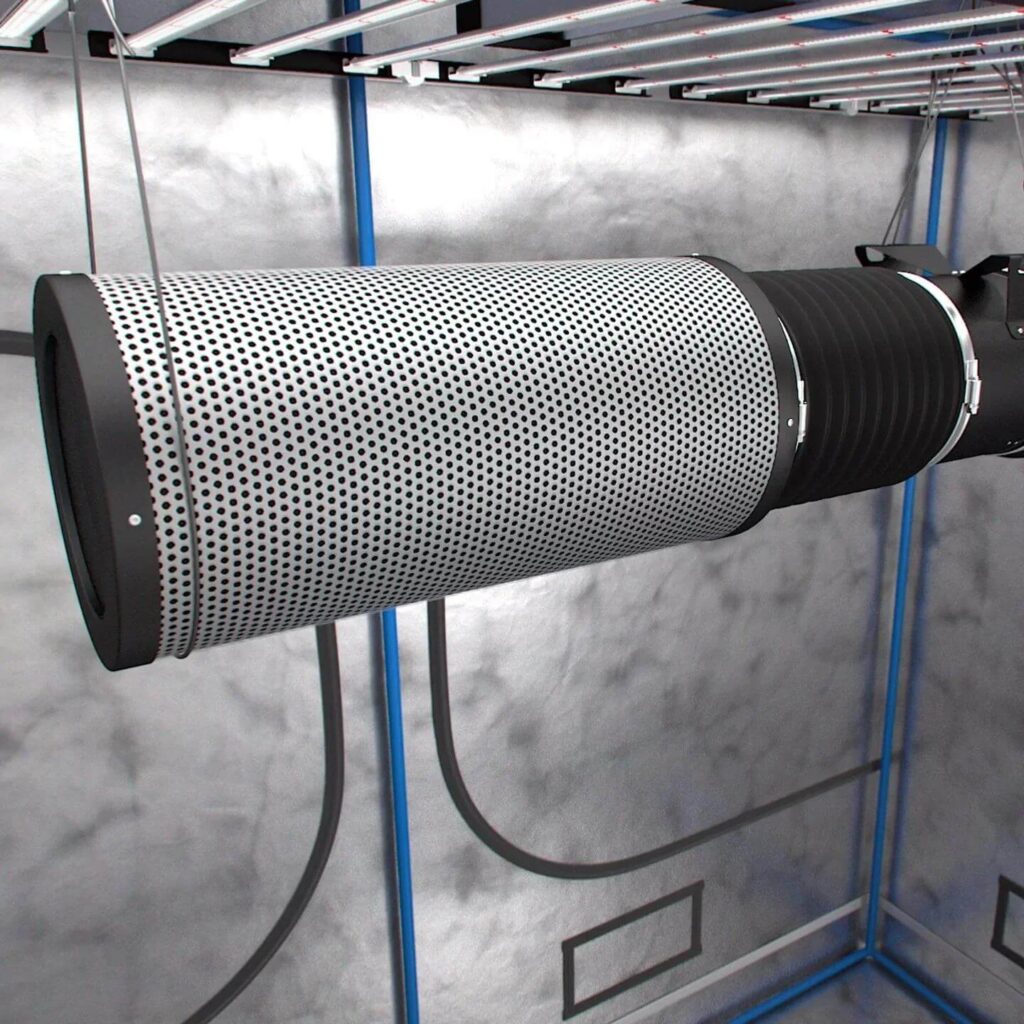
Carbon block filters, particularly those with a rating of one micron or smaller, can be effective in filtering out iron along with other contaminants. However, it’s important to note that these filters are generally not the first choice for treating high concentrations of iron in water. They are more suitable for water with lower iron levels.
Ferrous Iron
In contrast to ferric iron, which is visible as tiny rust particles in water, ferrous iron, or ‘clear water’ iron, is much harder to detect since it dissolves uniformly in the water. Although water with ferrous iron initially looks clear, it becomes cloudy and starts to develop reddish-brown flakes upon exposure to air or other oxidizing agents.
How do you remove ferrous iron from water?
Water softeners and iron filters are most effective against ferrous iron in water. Here’s how both methods work:
Water softeners, known for their ability to remove hard minerals, can also effectively filter out ferrous iron, usually up to concentrations of 2-5 ppm. This is achieved through ion exchange, a process where the softener’s resin beads exchange their negatively charged ions with the positively charged ions in the water.
Iron, being positively charged, is attracted to and captured by these resin beads, swapping places with sodium ions, much like calcium and magnesium. The system also regularly undergoes a backwashing process to clear accumulated iron from the resin.
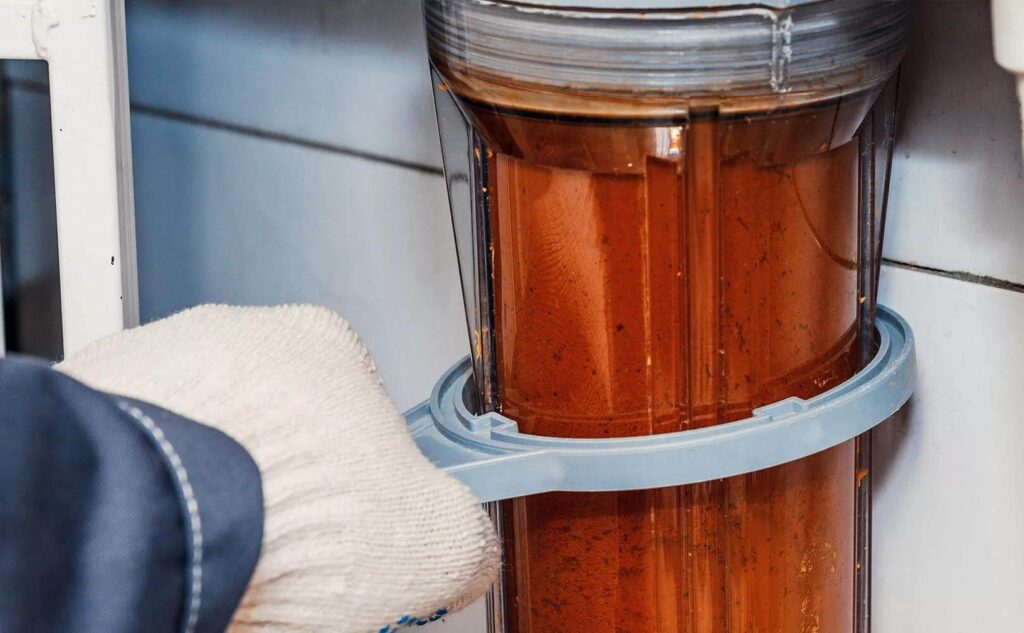
The efficiency of water softeners in removing ferrous iron is influenced by several factors including the water’s hardness, pH level, and exposure to air. They are less effective in conditions of low hardness, high iron content, a pH level above 7, or in systems like air-charged pressure tanks where water contacts air. Regular regeneration of the softener is essential to sustain its ability to remove iron effectively.
Iron Filter
Air Injection Oxidizing Filter Systems, a type of iron filter, operate by infusing oxygen into the water. This exposure to oxygen causes ferrous iron to oxidize, transforming it into ferric iron, which is insoluble. The insoluble ferric iron can then be efficiently filtered out.
After its conversion to ferric iron, the system’s filter media captures and holds the oxidized iron. This trapped iron is later expelled from the system during the backwash cycle. The media is specifically designed to seize oxidized iron and sulfur, thereby effectively purifying the water of these contaminants.
Organic Iron
Organic iron, also known as heme iron, occurs when iron molecules attach themselves to tannins present in groundwater. Tannins originate from decomposed organic materials like leaves and tree roots, often found in areas with decaying vegetation or swampy soils. Water containing organic iron typically has a distinctive yellow or brownish tint.
How do you remove organic iron from water?
To address iron oxidation in water, methods like chlorine or hydrogen peroxide injection are often used, but they require careful dosing to avoid potential health hazards. Organic iron, with its extremely small particles, poses a challenge for most filtration methods.
A notable solution is the JK-R1 Reverse Osmosis (RO) filter from our company. It utilizes a semipermeable membrane capable of trapping even the tiniest contaminants while allowing clean water to pass through. Although high iron levels can clog standard units, the JK-R1 is designed to handle such challenges more effectively, making it a superior choice over conventional options.
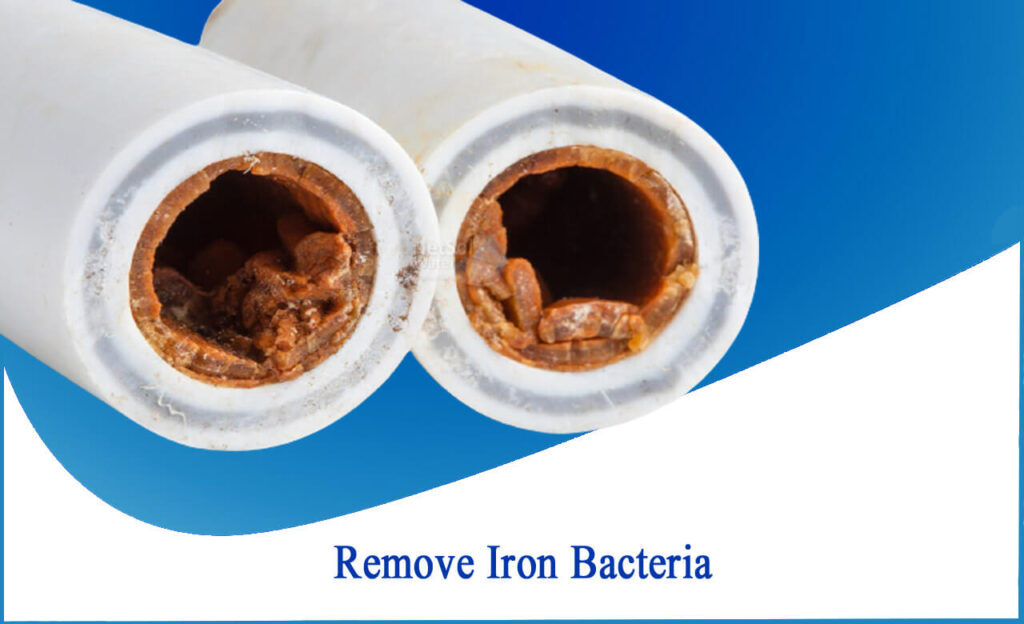
Bacterial Iron
Bacterial iron represents the most intricate type of iron found in water. Unlike typical bacteria that feed on decomposing organic materials, iron bacteria thrive by oxidizing dissolved ferrous iron or manganese in groundwater. This process results in the formation of iron deposits and a biofilm – a slimy substance in shades of red, orange, or brown. While these bacteria aren’t harmful to humans, they can foster an environment conducive to other harmful organisms and exacerbate existing iron issues. This biofilm can clog pipes and plumbing fixtures and often emits a foul odor resembling rotten eggs or sewage.
Iron bacteria are commonly found in shallow soil and groundwater. They can enter a well or water system during construction or repairs. In this article, we’ll outline strategies for preventing, removing, and treating iron bacteria, providing a concise overview of effective methods.
How do you remove iron bacteria from water?
Shock Chlorination
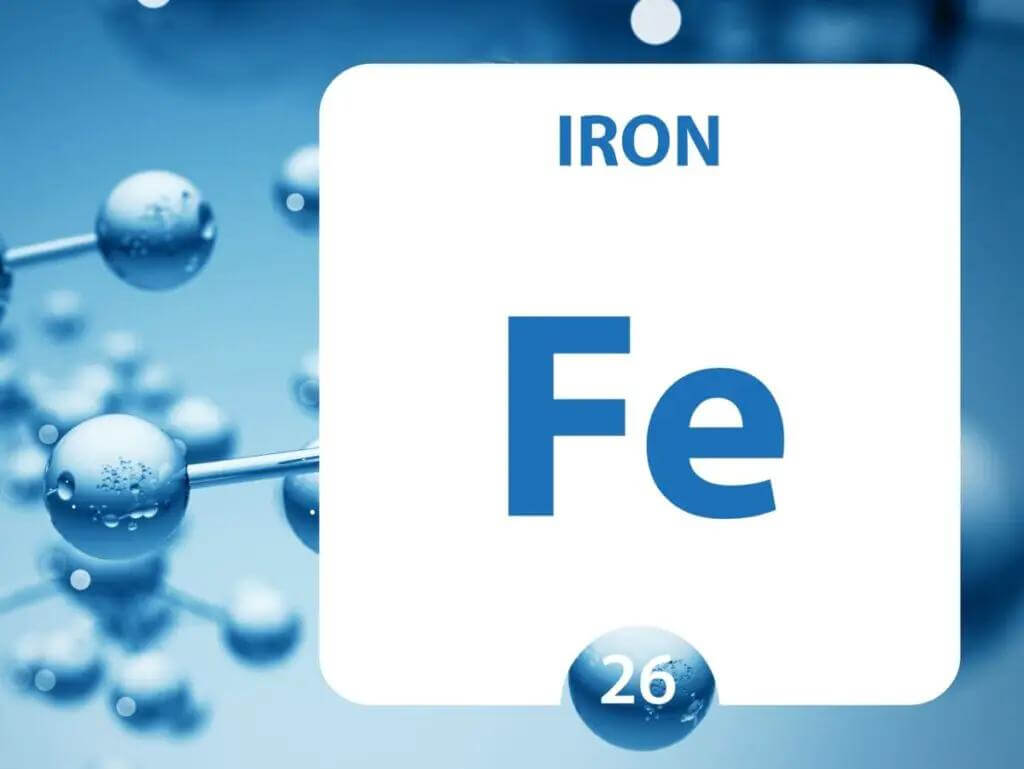
The most effective method for eradicating iron bacteria from well water is through shock chlorination. This technique involves introducing a substantial chlorine concentration, typically between 200-500 ppm, into the well. The purpose is to thoroughly eliminate the bacteria. The chlorine needs to remain in the well for a sufficient duration to guarantee a complete bacterial eradication. Following this, the well undergoes a thorough flushing process to expel both the chlorine and any residual bacteria. The final step in this process involves implementing a filtration system, a water softener, or an oxidizer to remove any remaining iron from the water.
Conclusion
Iron in your water, whether from well sources or corroded pipes in and around your home, can be detrimental to both your health and your home. The benefits of eliminating iron from your water are extensive – from improved water pressure to the extended lifespan of pipes and appliances, cleaner laundry, and enhanced skin and hair health. You’ll also notice a significant improvement in the taste, smell, and appearance of your water, which can elevate the quality of your meals and drinks. This could even inspire increased water consumption. Most importantly, removing iron from your water is more than just an aesthetic improvement; it’s a crucial step towards safeguarding your family’s health and ensuring a healthier living environment.
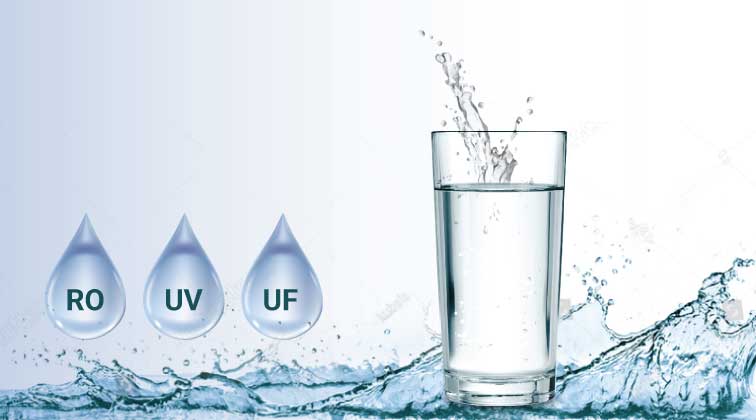
Our Mission
Our mission is to provide the simplest and most convenient solutions for water purification needs at various usage points, ensuring that consumers are not burdened with complex installations. We aim to empower brands to effortlessly integrate our water filtration products into their offerings, serving a broader range of customers. For instance, our PureFlowz faucet water purifiers directly address kitchen water needs, while our shower filter resolve bathing water concerns, protecting skin and hair. Our front-end filters safeguard household appliances from the detrimental effects of iron, and our advanced RO systems deliver comprehensive and safe drinking water. At the heart of our mission lies a commitment to making clean, purified water easily accessible in homes, enhancing health and daily living without any hassle.”
